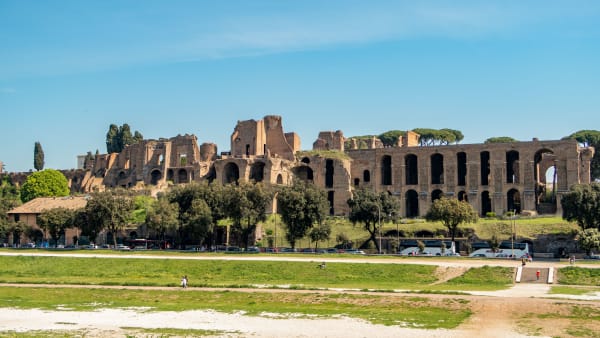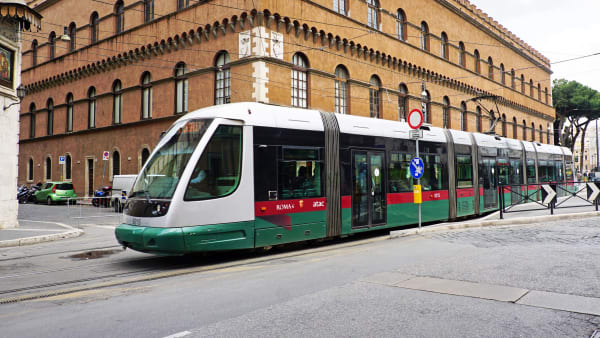Curiosities
Curiosities
Read on to discover the reasons behind many of the nicknames given to this monument, as well as the story of its fall from grace and subsequent revaluation.
The Biggest Typewriter in the World
As mentioned, the monument has long been mythologized as the temple of the national spirit, the essence of the values of freedom, patriotism, and unity.
Respected and valued, this piece has also been questioned more than once, both ideologically, aesthetically, and urbanistically. This is because many buildings dating back to Mediaeval Rome were taken down to make room for it. The whole floor plan of Piazza Venezia had to be reassessed. The whole operation cost a lot more than what was initially budgeted.
It is also often negatively associated with Fascism, even if the monument was built in the last decades of the 1800s, long before Mussolini declared himself Head of State, at the beginning of the 1920s. This association derives from the fact that Fascism, in a rather pompous (and predictable) way, appropriated many of the values represented in the monument.
In light of this, the Vittoriano ended up being scorned by Romans and thus nicknamed the typewriter or wedding cake. These terms aim to make fun of its color, shape, and maybe excessive dimensions. Regardless of these associations, the Monument is one of the most important works of art dating back to the Italian Unification.
The Dungeons
Not everyone knows that the Victorian has a vast and fascinating underground area. Most of it is occupied by the remains of a tufa quarry, which was used from the age of Emperor Trajan (98-117) for the extraction of building material.
The quarry came to light during the construction of the Vittoriano, forcing the architect Giuseppe Sacconi to revise the project and build massive foundations to support the building.
Particularly noteworthy is the use that was made of the basement when it came back into use, during the Second World War. Many of the rooms were converted into air-raid shelters, equipped with first-aid posts, drinking water supplies, emergency exits, benches attached to the walls, and toilets.
On the stone walls, several inscriptions can be identified that bear witness to this difficult time: “Hungry like a wolf”, “Double hunger” or “Fettuccine”.
The Unknown Soldier’s Interior Crypt
As mentioned in the previous sections of this article, the body of the Unknown Soldier was buried under the Altar of the Fatherland on 4 November 1921, as a tribute to all the fallen of the conflict.
What many people do not know, however, is that, a few years later, it was decided to also build a crypt inside. It was inaugurated in 1935, under Armando Brasini’s guidance.
The altar inside corresponds perfectly with the tombstone outside. It is decorated with an inscription justifying the Gold Medal for Military Valour (Italy’s highest military decoration).
“Worthy son of a valiant lineage and of a millenary civilization, he resisted unflinchingly in the most contested trenches, lavished his courage in the bloodiest battles, and fell fighting with no other prize to hope for than victory and the greatness of the Fatherland.”
The door of the simulacrum bears instead of the following epitaph, which was written by King Victor Emmanuel III of Savoy himself:
“His name unknown - his spirit thunders - wherever Italy is - with a voice of tears and pride - countless mothers say: - he is my son”.
Opposite the crypt is a chapel with a Greek cross floor plan. The floor is made of slabs of Karst marble, the altar was carved from a block of rock from Monte Grappa. Both are in memory of the places where WWI was fought.
Both the tomb and the chapel are decorated with a cycle of mosaics made by the Tuscan painter Giulio Bargellini before 1934. The crypt features a Crucifixion on the back wall. The chapel instead has a Madonna of Loreto in the dome and Saints protectors of the various Arms in the drum: St Martin, St George, St Sebastian, and St Barbara.
Giuseppe Garibaldi’s Stretcher and the Blue Jeans
As mentioned before, the Central Risorgimento Museum houses relics that marked important events in the history of the Italian Unification. Among them are the original trousers that Giuseppe Garibaldi wore during the feat of the Thousand and the real stretcher with which he was rescued in Aspromonte in 1862.
The trousers were made from the fabric used by Genoese sailors. It is thought that the city of Genoa and the color blue gave blue jeans their name.
The trousers preserved in the Museum are the ones Garibaldi wore in 1860 during the feat of the Thousand and with which he led the war in Sicily. This rare relic was donated by his sons. A symbolic tricolor ribbon was placed around the buttons.
The stretcher dates back to the events that took place after the Unification of the majority of the peninsula. At that time, the problem of how to conquer Rome - the ideal capital of Italy - became explicit, as Rome remained under the temporal rule of Pius IX.
Thus began the enterprise led by Giuseppe Garibaldi who, in 1862, decided to go up the peninsula with a group of volunteers to conquer Rome. To avoid international consequences, the government decided to stop Garibaldi by force. Twelve of Garibaldi’s men died, but he was wounded on the leg on Aspromonte and carried to safety on that same stretcher.
All the objects linked to this episode were preserved and donated to the museum: the boot with the bullet hole, the bullet, the bloody bandages, the stretcher, and the blanket.
The relics of Saint Pope John
Another museum in the Vittoriano where illustrious memorabilia is on display is the Shrine of the Flags. A relic and some objects belonging to Pope John XXIII are displayed here.
Born Giuseppe Angelo Roncalli, he was elected Pope on 28 October 1958 and is remembered as the ‘Good Pope’. He was beatified by Pope John Paul II on 3 September 2000 and canonized together with John Paul II on 27 April 2014 by Pope Francis. He is the patron of the Italian Army since 2017.
Roncalli served as a soldier in the 73rd Infantry Regiment, achieving the rank of Corporal. He was later recalled to service with the rank of Health Sergeant and finally, during WWI he served, at his specific request, as a military chaplain at Bergamo Hospital. His personal effects as a soldier, together with a relic, have been kept in the Shrine of the Flags since May 2017.
The First King of Italy
Victor Emmanuel II (1820 - 1878) was the most beloved of the kings of the House of Savoy, also because of his human qualities. Having become King of Sardinia in 1849, he placed Piedmont, his native region, at the head of the unification project, crowned in 1861 and then again in 1870 with the capture of Rome.
Among the various proposals put forward in the Risorgimento, in the end, the monarchical path prevailed, linked to the Savoy dynasty, King of Sardinia, and then of Italy.
When he died on 9 January 1878, he was hailed as the gentleman king and the Father of the Homeland. The following days were crucial in organizing the funeral rite and commemoration. While the king’s body was buried in the Pantheon, the government soon began planning the future Vittoriano.
A Stage for the Regime and the March on Rome
For a long time in the past, and sometimes still today, Vittoriano has been sadly associated with Fascism and its leader, Mussolini. This section will attempt to explain the reasons for this and above all to deconstruct this myth.
During his rise, Mussolini did not yet have a founding site in Rome to symbolically represent his power. The dictator, therefore, chose to appropriate the values and national-patriotic tradition represented by the Vittoriano, as the emblem par excellence of the country’s unification.
Choosing the monument as a means of self-celebration and as a propaganda poster for the regime, Mussolini decided to choose the Vittoriano and Palazzo Venezia as the final stage of the famous March on Rome.
The term “March on Rome” refers to the armed demonstration of 28 October 1922, organized by the National Fascist Party, the success of which led to the party’s rise to power in Italy. On that date, some 50,000 fascist soldiers marched on the capital threatening to seize power through violence.
When they arrived at the Vittoriano, Mussolini paid his respects at the tomb of the Unknown Soldier and accepted the commission to form the government, granted by King Victor Emmanuel III.
It was then from Palazzo Venezia (as described in our article on this monument) that the dictator made his bellicose statements that led Italy into the Second World War.
We should therefore not make the mistake of assuming that the very foundation of the monument is linked to the Fascist party. The Fascists came to power only in the 1920s, when the monument had already been inaugurated more than a decade before, and its construction almost complete.
The Bombing and the Vittoriano on Trial
In the post-war period, the Monument, precisely because it had been the stage for the Fascist Regime, was the object of deep criticism and misfortune, which lasted also in the following decades.
There was a revival of the popular criticism already mentioned: ’typewriter’, ‘wedding cake’ and other nicknames became customary.
On 12 December 1969, at 5.30 PM, at the same time as the Piazza Fontana massacre in Milan, two bombs exploded inside the Vittoriano. The attack caused heavy damage to the building, but fortunately no victims. To prevent further attacks, it was decided to close the monument to the public.
The decline of the building continued in the following years. The situation did not improve with the opening of the Museo Centrale del Risorgimento in 1970, which in turn was closed after only nine years, in 1979.
In 1986, the nearby Palazzo Venezia hosted a curious “trial” of the Vittoriano, whose aim was its demolition. Intellectuals and critics then accused it of “extraneousness and overpowering the surrounding city”.
The court finally rejected the prosecution’s petition for demolition. Thus ended the trial of the monument to Victor Emmanuel II, accused basically of aesthetic offense.
The Reopening
After being closed for almost 30 years, from 1969 to 1997, the entire Vittoriano complex was re-evaluated. Carlo Azeglio Ciampi, the tenth President of the Italian Republic, began to bring the monument back into the lives of citizens.
The President made it the basis of his policy based on the re-appropriation of places and symbols of the country’s history. After careful restoration work, the Monument was reopened to the public on 24 September 2000, in conjunction with the opening ceremony of the school year.
The President’s work was then taken up and continued by his successor, Giorgio Napolitano, with particular emphasis during the celebrations of the 150th anniversary of the Unification of Italy.
On that occasion, the celebrations on 17 March began at the Vittoriano, which was opened extraordinarily for the occasion. Mameli’s anthem was performed by the Ministry of Defence’s Interforce Band.
Afterward, Gruppo IX Invicta performed marvelous period fireworks, which lit up the capital’s sky from the Parco del Celio, reproducing the pyrotechnic art of 19th-century Italy.















